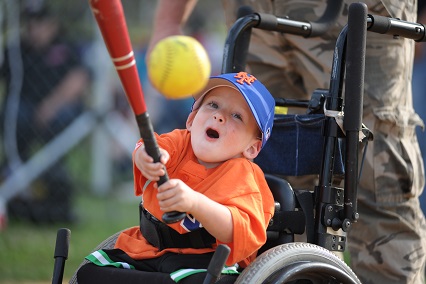By Allison Colman, Program Manager, National Recreation and Park Association
For many Americans, meeting the daily physical activity recommendations can be a challenge. Between work, family and everyday responsibilities, it can be difficult to find the time to put personal health and wellness needs first. Local park and recreation agencies can offer a solution to that challenge. In fact, people who use parks and open spaces are three times more likely to achieve the recommended levels of physical activity than nonusers.
Park and recreation agencies are located in nearly every community across the country, offering a wide variety of health and wellness programs and activities for all ages and populations. These facilities and public spaces encourage physical activity, mental health, socialization, a connection to nature, and promote health equity in low-income, underserved communities. In addition to providing a safe place for Americans to be active, park and recreation agencies offer numerous health and wellness programs that are cost-effective, evidence-based and supportive of the Physical Activity Guidelines for Americans.
Every July, the National Recreation and Park Association (NRPA) and local municipalities across the country celebrate the significant role that park and recreation agencies play in promoting health and wellness. This year, the theme for Park and Recreation Month is “Get Your Play On.” What better way for Americans to get fit and healthy than by playing in their local park?
Here are a few ways to promote physical activity and “Get Your Play On” this summer at a local park:
Emphasize the Importance of Play
Play and physical activity opportunities for youth, especially outdoor opportunities, have been declining for decades. Children today spend less time outdoors than any other generation. They devote only four to seven minutes to unstructured outdoor play per day, while clocking in seven and half hours in front of electronic media. By offering programs and spaces that promote free play and unstructured activities, park and recreation agencies are connecting kids to the outdoors (like these in Portland, OR). These parks and recreation facilities also help families and children maintain a healthy weight, build muscular strength and bone health, develop fundamental kinetic movement skills, and improve balance and coordination. Facilitating play in this way contributes to a reduced risk for chronic disease later in life. In addition, unstructured play stimulates creativity and imagination, encourages children to take risks, and provides a sense of accomplishment and increased self-esteem.
Make Inclusion a Priority
Just a few weeks ago, Eunice Kennedy Shriver was honored with the Arthur Ashe Courage Award at the ESPY’s for her role in founding the Special Olympics. Her leadership serves as a long-lasting example of the importance of inclusion and accessibility in recreation and physical activity programs. Park and recreation programs like the one in the City of Carmel, CA are invested in providing inclusive environments for all individuals to meet healthy living goals. From Special Olympics to physical activity programs for seniors suffering from chronic disease and disability, parks and recreation are dedicated to ensuring that all members of the community have access to quality programming that supports health and wellness needs, regardless of physical ability.

Include Physical Activity Programming for Older Adults
As the population continues to transform, one area of interest for local government agencies is the expanding population of older adults. NRPA recently published the Healthy Aging in Parks Survey, reinforcing the critical role that local agencies play in ensuring older adults have access to physical activity programs. Nine in 10 park and recreation agencies dedicate facilities, amenities and programming to older adults, with 91 percent offering exercise classes, 53 percent offering group walks, and 48 percent offering volunteer and employment opportunities in recreation centers. One example of successful adult programming is through NRPA’s Healthy Aging in Parks initiative, which encourages local park and recreation agencies to implement evidence-based arthritis intervention programs (like the Arthritis Foundation’s Walk with Ease Program) that help individuals maintain physically active lifestyles while reducing arthritic symptoms and pain. Communities in Buckeye, Arizona and Forest Park, Illinois have helped numerous older adults improve their cardiovascular health, flexibility, and muscular strength through these programs. In addition to the cardiovascular and muscular benefits, physical activity is proven to reduce stress, anxiety, and depression in older adults, providing additional mental health benefits for individuals and the community.
Parks and recreation provide crucial health and wellness opportunities for all populations in communities across the country. As America continues to face serious health issues including rising rates of chronic disease, more time being sedentary, and a decline in time spent outdoors, park and recreation agencies offer an affordable and accessible solution. Encouraging communities to explore local parks and recreation this summer and “Get Your Play On” is a great way to help individuals meet the daily physical activity recommendations.
Spread the Word! Share this post with your network using this sample tweet: Parks & recreation are vital to physical & mental wellbeing. Celebrate with @NRPA_News on the BAYW blog! http://bit.ly/2eNIv7j #PlayOnJuly
____________________
The National Recreation and Park Association (NRPA) is the leading non-profit organization dedicated to the advancement of public parks, recreation and conservation.